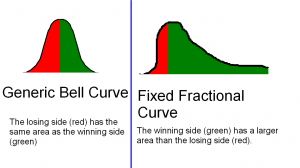Trading totally at random with a 50% winning percentage and an R multiple of 1 yields no advantage, as I discussed last week in modeling money management. Remember that an R multiple is the average win to the average loss. Such a system poses neither an advantage or disadvantage. The average outcome should come out extremely close to the starting balance.
Most traders focus on risking a set dollar amount such as $1,000 on a given trade. Fixed fractional money management updates that dollar figure after every single trade. It changes the overall outcome after you add up all the winners and all of the losers. Remember that trading is the net outcome of several hundred trades or even thousands of trades. The power of money management comes into play as the number of trades increases.
Fixed fractional money management stretches some portions of the bell curve and compresses other regions. Before we get into that, it's important to remember what fixed fractional money management means. It stands for the idea of risking a set percentage of the current account equity rather than the starting equity.
Consider an example where the account balance starts at $100,000 risking 1%. Both methods risk the same amount on the first trade, $1,000. The next trade, however, will yield a different risk amount. A win on the previous trade would increase the account equity to $101,000. One percent of a 101 grand is $1,010 of risk on the next trade. A whopping ten dollar change.
That may seem trivial. It is most certainly not over the long run.
Examples
Consider a trader that plays the coin toss game and has a system with the following characteristics:
He starts with a $100, 000 account balance
His R multiple is 1.0
He wins 50% of the time with no trading costs
He risks 1%
The absolute worst outcome of playing the coin toss with a fixed dollar risk of $1,000 is a loss of $46,000. Adding fixed fractional money management during that difficult drawdown improves the drawdown to a less substantial loss of $37,500. The worst drawdown goes from -46% to -37.5%. The method drags the absolute worst case scenario and pulls it closer to the average. When an unlucky, devastating drawdown kicks in, the technique reduces the losses that the trader experiences.
The best case scenario for fixed dollar risk is a $58,000 (58%) return. Adding money management to the system dramatically stretches the best case scenario further to the right. It improves to a $76,000 return (76%). The good times get a lot better without changing anything at all about the trading system. The method stretches positive returns away from the average. The trader walks away with more money in his pocket.
The natural instinct is to conclude that fixed fractional money management is the way to go. I agree. It improves the risk reward profile of a totally random strategy. Adding it to a real trading system should help control parameters that most traders consider critical like drawdowns and maximizing the return.
An important consequence of using fixed fractional money management, however, is that the odds of receiving a below average return increase somewhat. The coin toss game suffered a below average return 47% of the time. Applying fixed fractional money management increased the likelihood of a below average return to 53%. The effect is not all that much. Losing is more likely. But when it happens, the "loss" is so negligible that it can be thought of as breaking even.
Random numbers occasionally follow a seemingly non-random pattern such as loss-win-loss-win. When this occurs, the size of the trade on the losses is bigger than the trade size of the winners. Even if the winning percentage comes out at precisely 50%, those wins get slightly overshadowed by the losers. That micro effect of slightly larger losses than gains shows up as a slightly increased risk of not making as much money as expected.
Graphing all outcomes

Red areas represent the losing outcomes while green areas represent the winners. Money management is really about maximizing the ratio of green area to red area. Random trades with no expectation of profit yield a bell curve, which appears on the left.
Fixed fractional moves the highest density of returns slightly to the left. Doing so creates the trivial disadvantage of a slightly increased risk of negligible loss. Importantly, the far left side (the worst case loser) gets dragged much closer to the average. The far right side (the best case winner), gets stretched much further from the average. The goal is to make the green area larger than the red area to where we actually expect a profit.